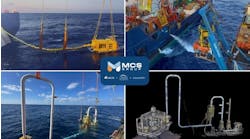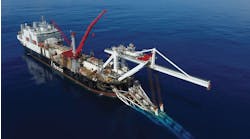Offshore staff
DAMMAM, Saudi Arabia -- Saudi Aramco proved new reserves close to at least three of its offshore fields last year, according to the company’s 2009 annual report.
Positive results came from the offshore Lawhah-46 well, which flowed 30 MMcf/d of gas from the Khuff B reservoir; the Arabiyah-101 offshore delineation well that flowed 11.7 MMcf/d and 20 b/d of condensate from the Jilh reservoir; and the Hasbah-17 offshore delineation well (47.5 MMcf/d from the Khuff B reservoir).
On the offshore development front, the company has been working on several major offshore greenfield and life extension projects. Its newest large-scale program is Karan, Aramco’s first-ever non-associated gas increment, due to be completed in 2013.
Karan involves drilling 19 wells on four production platforms linked to a tie-in platform, from which the commingled gas will head through a new 110-km (68-mi) subsea pipeline to the onshore Khursaniyah gas plant. By the end of last year, detailed design of the subsea pipeline, which will transport up to 1.8 bcf/d of gas, was 73% complete.
Reception facilities to be added at Khursaniyah will include three processing trains, each with a capacity of 600 MMcf/d, gas sweetening and dehydration equipment, and a sulfur recovery unit.
Aramco describes its offshore Manifa increment as an oil “mega-project”. It is designed to start production of 500,000 b/d of Arabian heavy crude by June 2013, rising to 900,000 b/d by January 2024. The aim of the program is to offset natural production declines at other fields.
Manifa is in shallow waters close to the Kingdom’s east coast, north of Jubail. Development entails addition of new central processing facilities for gas/oil separation, wet crude oil handling and stabilization, gas gathering and compression, and water disposal.
The program also calls for construction of a causeway across Manifa Bay, drilling islands for oil producer and water injector wells, and offshore platforms.
Another project, classified as a “Maintain Potential Program”, involves expanding offshore facilities at the Safaniyah field. In 2009, Aramco added 27 new platforms to the existing complex, connected 95 new wells and started installing a 42-in. (106-cm) diameter crude oil trunk line.
One of the critical additions was a tie-in platform with topsides weighing over 3,000 metric tons (3,307 tons), designed to gather oil from and supply electrical power to 12 production platforms with 120 wells.
Aramco is pressing for more local involvement in its offshore program. One yard in Dammam is fabricating five platforms for the Berri and Zuluf fields.
Among Aramco’s in-house technical programs, staff from the Mechanical Services division and the R&D Center evaluated the use of thermal spray aluminum coating on offshore structures.
Tests revealed that this method should require new coats every 15 years only, compared with two years for paint. Aramco has since applied thermal spray aluminium coating on the cellar and main deck of a platform under construction for the Karan project.
06/28/2010


